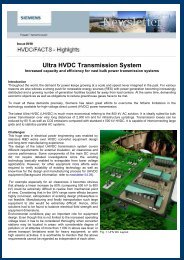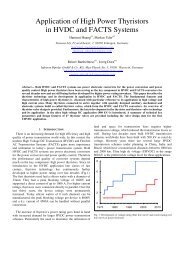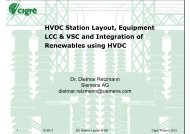Technology and Development of 800 kV HVDC ... - Siemens
Technology and Development of 800 kV HVDC ... - Siemens
Technology and Development of 800 kV HVDC ... - Siemens
Create successful ePaper yourself
Turn your PDF publications into a flip-book with our unique Google optimized e-Paper software.
3<br />
Limits due to transformer<br />
With increase in the rating <strong>of</strong> the project, the most likely reason for adopting two twelve pulse groups per pole<br />
would be the weight or size <strong>of</strong> converter transformer which may reach to values that it is no longer feasible to<br />
transport the converter transformer to the destined site. For a project <strong>of</strong> 4000 MW transmission capacity under<br />
bipolar mode, the size <strong>of</strong> even a single phase two winding transformer is about 394 MVA. This transformer may<br />
be about 12x4.5x5 meter, weighing around 400 tons <strong>and</strong> might already be approaching the limits <strong>of</strong><br />
transportation, which would depend upon the specific location <strong>of</strong> the converter terminals <strong>and</strong> influenced by the<br />
strengths <strong>of</strong> bridges en route, limits <strong>of</strong> roads <strong>and</strong> rails etc.<br />
Limits due to thyristor<br />
A U<strong>HVDC</strong> project is generally required to meet steady state as well as overload conditions as determined by<br />
planners. The employed thyristors must be able to meet these conditions. With the present day capacity <strong>of</strong> about<br />
4 kA for thyristors the overload capacity is not a problem even with series connected valves <strong>of</strong> about 6000 MW<br />
capacity bipolar project which has a rated current <strong>of</strong> 3.75 amps at <strong>800</strong> <strong>kV</strong>. With higher rating projects or lower<br />
rated voltage a parallel arrangement <strong>of</strong> bridges or a use <strong>of</strong> bigger diameter thyristor may be considered.<br />
Comparison <strong>of</strong> Series / Parallel arrangement<br />
When the need for two twelve pulse groups arise, generally the series group may tend to be adopted mainly<br />
because the series groups maintain balance in the two pole currents even during an outage <strong>of</strong> a series group <strong>and</strong><br />
hence there are potentially no ground currents when one <strong>of</strong> the two series groups is out. In case <strong>of</strong> parallel<br />
groups the current in a pole is the addition <strong>of</strong> currents in each group, <strong>and</strong> hence, on outage <strong>of</strong> a group there<br />
would be an unbalance in the two pole currents giving rise to ground currents.<br />
With parallel groups, the currents in each group is only half <strong>of</strong> the pole current <strong>and</strong> there would be sufficient<br />
overload capacity left in the thyristor for the maximum size <strong>of</strong> projects under consideration. Therefore very high<br />
capacity links may find application <strong>of</strong> parallel groups on account <strong>of</strong> current rating <strong>of</strong> thyristors.<br />
On outage <strong>of</strong> group, the line losses would be considerably lower in case <strong>of</strong> a parallel group as compared to<br />
series group under similar outage, on account <strong>of</strong> fact that the pole current reduces to half in case <strong>of</strong> a parallel<br />
group outage.<br />
The parallel groups are highly adaptable to stage wise development. The parallel groups can easily be added to<br />
an existing pole with minimum <strong>of</strong> disturbance during commissioning. With parallel groups each group can<br />
easily be located at different places far from each other as per requirement or to reduce the cost <strong>of</strong> ac<br />
transmission system that connects at either end <strong>of</strong> the transmission for collecting <strong>and</strong> delivering power at<br />
different locations in the grid. This may have several system related advantages with regard to maintaining<br />
voltage pr<strong>of</strong>ile, reliability, stability etc.<br />
From the discussion above it is seen that the operating voltage, current <strong>and</strong> configuration <strong>of</strong> a project will be<br />
strongly influenced by the amount <strong>of</strong> power that has to be transmitted, location <strong>and</strong> the connected ac systems.<br />
FOCAL POINTS<br />
The major focal points for a U<strong>HVDC</strong> project briefly discussed in the following sections are:<br />
• System Integration<br />
• Insulation Coordination<br />
• Converter Transformer <strong>and</strong> Bushings<br />
• Wall Bushings<br />
• DC Yard Equipment

















